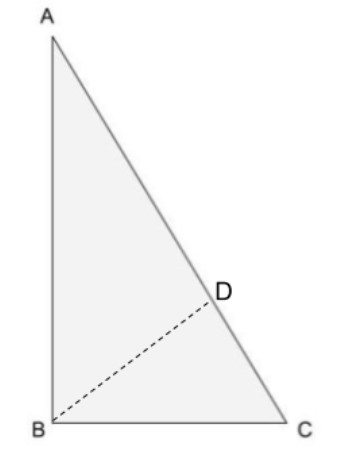
Prove that in any triangle, the side opposite to the larger angle is larger.
Answer
578.4k+ views
Hint:We know that the sides opposite to the equal sides are equal. Similarly the side opposite to the larger angle is larger.Using this concept we try prove the statement.
Complete step-by-step answer:
Generally this is the theorem that the side opposite to the larger angle is larger. So now let us see how.
Let $ABC$ be a triangle.

Let us assume that $\angle ABC > \angle ACB$
So if we prove that $AC > AB$, then it is clear that the side opposite to the larger angle is larger.
For this proof we need the construction.
So construct $BD$ on $AC$ such that $\angle DBC = \angle ACB$
As $\angle ABC > \angle ACB$, so we can find a point on $AC$ that is $D$ such that $\angle DBC = \angle ACB$.
As construction is done, it divides $\Delta ABC$ into two triangles that are $\Delta ABD$ and $\Delta DBC$.

Now in $\Delta DBC$,
$\angle DBC = \angle ACB$
As we constructed $BD$ such that the two angles are equal.
Now we know that in the triangle, the sides opposite to equal angles are equal.
So $BD = DC$ $ - - - - - - - \left( 1 \right)$
Now we can add $AD$ on both sides of this above equation,
$AD + BD = DC + AD$
Now if solve $AD + DC$, we get $AC$
So $AD + BD = AC$
Or we can say that,
$AC = BD + AD$ $ - - - - - - - \left( 2 \right)$
Now in $\Delta ADB$,
We know that for any triangle to form, the sum of two sides will always be greater than the third side.
So $BD + AD > AB$ $ - - - - - - - - \left( 3 \right)$
Now putting the value of $AD + BD = AC$ in equation (3),
So we get $AC > AB$.
Hence it is proved that $AC > AB$ if $\angle ABC > \angle ACB$
Hence we can say that the side opposite to the larger angle is larger.
Note:Let for any triangle $ABC$, by applying the $\sin $ rule we get,

$\dfrac{{\sin A}}{a} = \dfrac{{\sin B}}{b} = \dfrac{{\sin C}}{c}$
So if $\angle A > \angle B$,
$\sin A > \sin B$ as $\sin $ is the increasing function.
So $\dfrac{{\sin A}}{a} = \dfrac{{\sin B}}{b}$
$a = \dfrac{{\sin A}}{{\sin B}}b$ and $\sin A > \sin B$
So $a > b$
Hence Proved.
Complete step-by-step answer:
Generally this is the theorem that the side opposite to the larger angle is larger. So now let us see how.
Let $ABC$ be a triangle.

Let us assume that $\angle ABC > \angle ACB$
So if we prove that $AC > AB$, then it is clear that the side opposite to the larger angle is larger.
For this proof we need the construction.
So construct $BD$ on $AC$ such that $\angle DBC = \angle ACB$
As $\angle ABC > \angle ACB$, so we can find a point on $AC$ that is $D$ such that $\angle DBC = \angle ACB$.
As construction is done, it divides $\Delta ABC$ into two triangles that are $\Delta ABD$ and $\Delta DBC$.

Now in $\Delta DBC$,
$\angle DBC = \angle ACB$
As we constructed $BD$ such that the two angles are equal.
Now we know that in the triangle, the sides opposite to equal angles are equal.
So $BD = DC$ $ - - - - - - - \left( 1 \right)$
Now we can add $AD$ on both sides of this above equation,
$AD + BD = DC + AD$
Now if solve $AD + DC$, we get $AC$
So $AD + BD = AC$
Or we can say that,
$AC = BD + AD$ $ - - - - - - - \left( 2 \right)$
Now in $\Delta ADB$,
We know that for any triangle to form, the sum of two sides will always be greater than the third side.
So $BD + AD > AB$ $ - - - - - - - - \left( 3 \right)$
Now putting the value of $AD + BD = AC$ in equation (3),
So we get $AC > AB$.
Hence it is proved that $AC > AB$ if $\angle ABC > \angle ACB$
Hence we can say that the side opposite to the larger angle is larger.
Note:Let for any triangle $ABC$, by applying the $\sin $ rule we get,

$\dfrac{{\sin A}}{a} = \dfrac{{\sin B}}{b} = \dfrac{{\sin C}}{c}$
So if $\angle A > \angle B$,
$\sin A > \sin B$ as $\sin $ is the increasing function.
So $\dfrac{{\sin A}}{a} = \dfrac{{\sin B}}{b}$
$a = \dfrac{{\sin A}}{{\sin B}}b$ and $\sin A > \sin B$
So $a > b$
Hence Proved.
Recently Updated Pages
Master Class 12 Economics: Engaging Questions & Answers for Success

Master Class 12 Maths: Engaging Questions & Answers for Success

Master Class 12 Biology: Engaging Questions & Answers for Success

Master Class 12 Physics: Engaging Questions & Answers for Success

Master Class 8 Maths: Engaging Questions & Answers for Success

Class 8 Question and Answer - Your Ultimate Solutions Guide

Trending doubts
What is meant by exothermic and endothermic reactions class 11 chemistry CBSE

Which animal has three hearts class 11 biology CBSE

10 examples of friction in our daily life

One Metric ton is equal to kg A 10000 B 1000 C 100 class 11 physics CBSE

1 Quintal is equal to a 110 kg b 10 kg c 100kg d 1000 class 11 physics CBSE

Difference Between Prokaryotic Cells and Eukaryotic Cells




